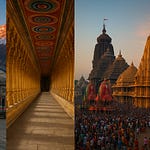Perched on a sacred rock amidst the gushing waters of the Alaknanda River, the Dhari Devi Temple is more than just a place of worship — it is a timeless symbol of divine wrath, spiritual protection, and sacred femininity. Located in Uttarakhand's Pauri Garhwal district, this open-air shrine is revered as the guardian deity of the Char Dham — four of the holiest Hindu pilgrimage sites nestled in the Himalayas. Unlike most temples adorned with domes and grandeur, Dhari Devi Temple stands exposed to the elements, embodying the fierce and unyielding spirit of Goddess Kali in her rawest form.
Her idol, seated without a roof by divine command, is said to change its form throughout the day, a phenomenon that adds mysticism to an already awe-inspiring legend. Stories of miracles, protection from natural disasters, and her divine justice continue to draw pilgrims, spiritual seekers, and curious minds alike. The temple holds special prominence not just for its mythological depth but also for the modern tragedy associated with the 2013 Uttarakhand floods, which many believe were a direct result of her displacement.
From ancient legends to modern faith, Dhari Devi’s presence looms over the hills and hearts of Uttarakhand as a living deity—unbound by bricks and walls, but rooted deeply in the collective spiritual consciousness of the region.
📖 Origin & Mythological Significance
The name Dhari Devi is derived from the village Dharo, where the idol was found and later enshrined. As per legends, the idol of the goddess was washed away during a flood, and when the villagers tried to recover it, they heard a divine voice commanding that she should not be sheltered under a roof and should be installed on a rock in the open sky.
The Goddess Dhari is regarded as an avatar of Goddess Kali and is worshipped in her wrathful form. She is believed to protect the Char Dham — Kedarnath, Badrinath, Gangotri, and Yamunotri — and the devotees who undertake these sacred pilgrimages.
Her idol is said to change facial expressions throughout the day — appearing as a young girl in the morning, a mature woman in the afternoon, and an old lady in the evening.
🧿 The Legend of the Goddess
According to folklore, centuries ago, during a flood, the idol of the goddess was trapped against a rock. The villagers who discovered it heard a supernatural voice instructing them to place the idol at that location permanently, in the open. Since then, that exact spot became the foundation of the Dhari Devi shrine.
She is said to be the upper torso of Goddess Kali, while her lower part is worshipped at Kalimath, one of the 108 Shakti Peeths — a unique dual worship rarely seen in Hindu tradition.
🏗️ Architecture and Layout
The temple is humble in design yet powerful in energy. The sanctum sits atop a rock, surrounded by the flowing Alaknanda River. It is roofless, honoring the legend that the goddess refuses to stay under a roof.
Previously, the temple was accessible only via boat, but now a bridge connects it to the mainland. The architectural theme respects the natural terrain and spiritual traditions, ensuring no structure overshadows the sanctity of the goddess’s wishes.
🙏 Rituals, Puja & Aarti
Dhari Devi is worshipped with intense devotion and simple rituals:
Daily Aarti Timings:
Morning Aarti: 6:00 AM – 6:30 AM
Evening Aarti: 6:30 PM – 7:00 PM
Main Offerings: Flowers, red cloth, sweets, mustard oil lamps, and vermillion (sindoor).
Special Occasions: Navratri is celebrated with great fervor. Devotees observe fasts and organize jagran (night-long singing of devotional songs).
Unlike other temples, animal sacrifices are strictly prohibited. The rituals are symbolic, invoking the fierce yet motherly energy of the goddess.
📅 Festivals Celebrated
Navratri (both Chaitra & Ashwin): Devotees from across North India visit during these auspicious days.
Diwali and Dussehra: Light, music, and devotion fill the air.
Foundation Day (Anniversary of Idol Installation): Local community celebrations.
⚠️ 2013 Idol Relocation & Kedarnath Floods
One of the most spine-chilling associations with Dhari Devi is the 2013 Uttarakhand floods. On June 16, 2013, the government relocated the idol to make way for a hydroelectric project. Within hours, unprecedented rains triggered one of the worst natural disasters in Indian history, leading to massive destruction and loss of life, especially near Kedarnath.
Locals and sages believe the disaster was a direct consequence of the deity’s wrath due to her displacement — a stark reminder of the sacred energies that ancient traditions respect but modernity often forgets.
After public outcry and spiritual alarm, the idol was reinstated at a higher platform at the same site — without a roof, as per the original instruction.
🧘 Devotee Faith & Spiritual Power
Thousands of pilgrims visit annually, especially before and after Char Dham Yatra, to seek blessings for:
Protection during travel
Relief from health problems
Resolving family disputes
Removal of negative energies
Locals believe that the village and nearby towns are never harmed by natural calamities as long as the goddess is worshipped properly.
🧭 Travel Guide
🛣️ How to Reach
By Road: Well connected by roads from Srinagar (15 km), Rudraprayag (35 km), Rishikesh (120 km).
By Train: Rishikesh Railway Station is the nearest major railhead.
By Air: Jolly Grant Airport, Dehradun is about 140 km away.
🏨 Accommodation
Guest houses and lodges in Srinagar (Garhwal)
Basic dharamshalas available nearby
🕉️ Temple Visiting Hours
Opening Time: 6:00 AM
Closing Time: 8:00 PM
Best Time to Visit: March to June and September to November
Avoid the monsoon season due to potential landslides and flooding in the region.
📸 Nearby Attractions
Rudraprayag – Confluence of Alaknanda and Mandakini rivers
Kalimath Temple – Lower part of the goddess
Char Dham Sites – Kedarnath, Badrinath, Gangotri, Yamunotri
Srinagar Dam
The Dhari Devi Temple is not just a shrine—it is a living energy, a fierce and compassionate force guarding the Himalayan heartland. It is a must-visit spiritual destination, whether you're on the Char Dham Yatra or seeking blessings for life's journey. Her open-air sanctum reminds us that the divine cannot be confined and must be worshipped in truth, simplicity, and surrender.
The Dhari Devi Temple is a rare fusion of mythology, mysticism, and modern relevance. It stands not just as a spiritual site, but as a reminder of balance between tradition and transformation, divinity and development, nature and human ambition. Her story—flowing through the river, anchored in the rock, rising after displacement—echoes the spiritual resilience of India’s ancient wisdom.
For those embarking on the Char Dham Yatra, a stop at Dhari Devi’s abode is not merely a ritual—it is a powerful act of seeking protection and surrendering to the primal force of Shakti. For others, it is a place of reflection, a chance to witness faith in its rawest, most organic form, untouched by temple grandeur, yet deeply sacred.
Whether you seek blessings, answers, or simply a connection with something greater than yourself, the Dhari Devi Temple invites you to pause, offer, and feel. In the rustling river, the chill of the wind, and the silence of the mountains—you will find her presence, watching, guarding, and guiding.










